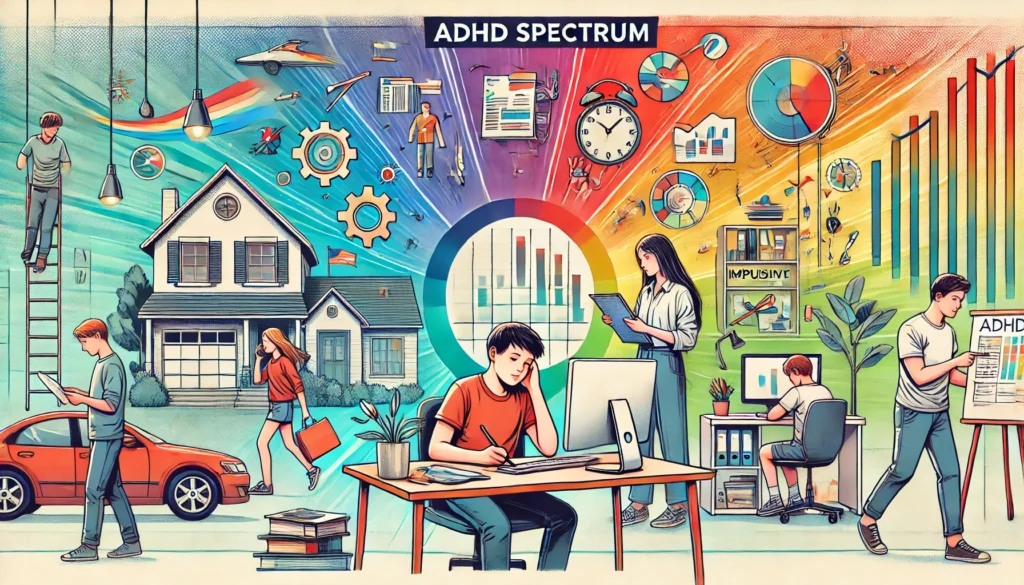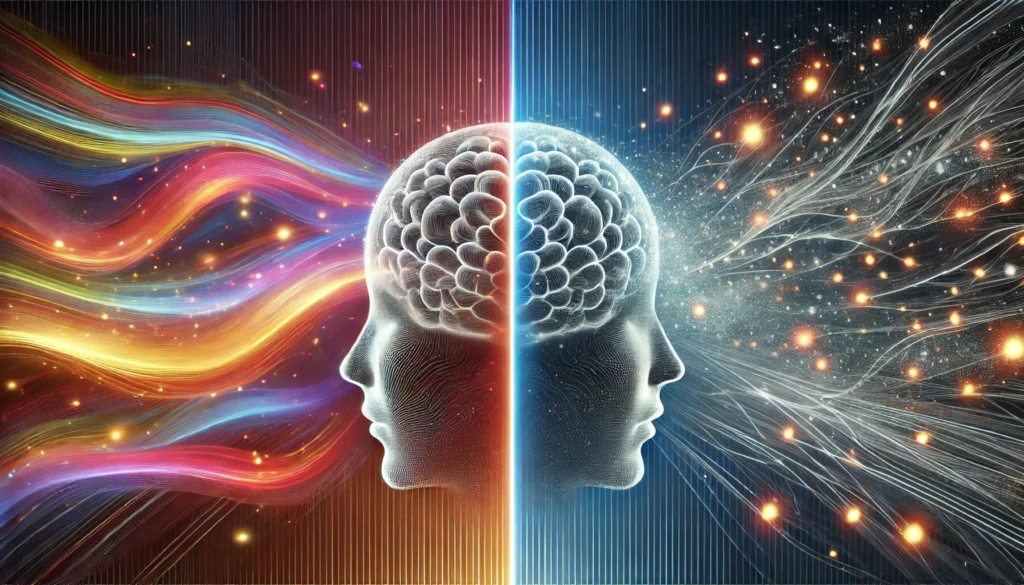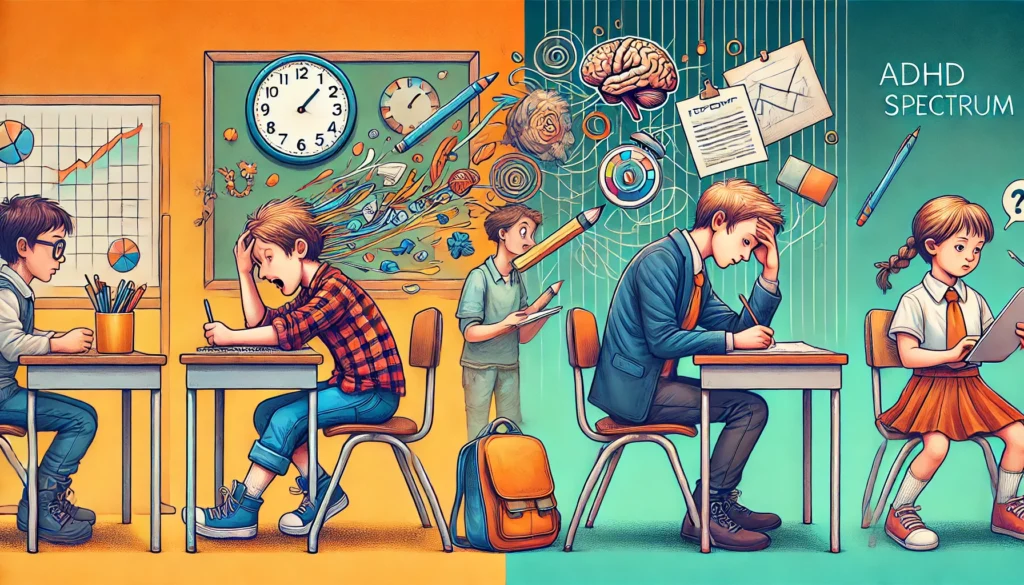ADHD, or Attention Deficit Hyperactivity Disorder, is a term that often conjures images of hyperactive children unable to sit still in a classroom. However, ADHD is far more nuanced than this stereotype suggests. As research has advanced, so has our understanding of ADHD as a spectrum of symptoms affecting both children and adults. This spectrum encompasses a wide range of behaviors and challenges, making it crucial to comprehend its impact on daily life.
You may also like: Enhancing Concentration: Strategies for ADHD
Understanding the ADHD Spectrum
The concept of the ADHD spectrum is essential for grasping the disorder’s complexity. The spectrum refers to the varying degrees of ADHD symptoms, which can range from mild to severe. These symptoms are divided into three main categories: inattentiveness, hyperactivity, and impulsivity. Individuals may experience a combination of these symptoms, which can fluctuate in intensity over time.
Inattentiveness
Inattentiveness is characterized by difficulty sustaining focus, disorganization, and forgetfulness. Those on the ADHD spectrum might find it challenging to complete tasks, follow instructions, or maintain attention during conversations. This can impact academic performance, work productivity, and even personal relationships.
Difficulty Sustaining Focus
Sustaining focus is a core challenge for individuals with ADHD. They might start a task with enthusiasm but quickly lose interest, jumping from one task to another without completion. This lack of sustained attention can be frustrating for both the individual and those around them, leading to misunderstandings and conflicts.
Disorganization and Forgetfulness
Disorganization is another hallmark of inattentiveness. Individuals may struggle to keep track of their belongings, appointments, or deadlines. This disorganization can lead to a chaotic lifestyle, where important tasks are forgotten, and priorities are mismanaged, affecting both personal and professional aspects of life.
Impact on Relationships
Inattentiveness can strain relationships. Partners or friends might feel neglected or unimportant when conversations are forgotten or plans are not followed through. This can lead to feelings of frustration and resentment, requiring open communication and understanding from all parties involved.
Hyperactivity
Hyperactivity manifests as excessive fidgeting, restlessness, or an inability to stay seated. This aspect of ADHD can be particularly challenging in settings that require prolonged periods of calm and concentration, such as classrooms or office environments.
Excessive Fidgeting
Fidgeting often serves as a physical outlet for excess energy. In academic or professional settings, this can be perceived as disruptive. Providing individuals with small, non-disruptive ways to channel this energy, like stress balls or standing desks, can be beneficial.
Restlessness
Restlessness isn’t limited to physical movement; it often extends to a restless mind. Individuals might feel an incessant urge to move or change activities, leading to difficulty in completing tasks that require prolonged focus. This restlessness can also manifest as an inability to relax, impacting leisure activities and sleep.
Challenges in Structured Environments
Structured environments like classrooms or boardrooms demand stillness and concentration, which can be particularly taxing for hyperactive individuals. Integrating short breaks or physical activities into routines can help manage hyperactivity and improve overall engagement.
Impulsivity
Impulsivity involves acting without forethought, which can lead to hasty decisions or interrupting others during conversations. This can affect social interactions and lead to potential safety concerns in daily life.
Acting Without Forethought
Impulsive actions often stem from an inability to pause and consider consequences. This can result in hasty decisions, such as impulsive spending or risky behavior, which might have long-term negative effects.
Interrupting Conversations
Social interactions can be challenging when impulsivity leads to frequent interruptions. This behavior can be off-putting to others, leading to strained relationships. Teaching individuals strategies to manage impulsivity, like pausing before speaking, can enhance social interactions.
Safety Concerns
Impulsivity can pose safety risks, especially in situations that require careful planning and forethought, such as driving or handling dangerous equipment. Awareness and proactive strategies, like mindfulness practices, can help mitigate these risks.

The ADHD Spectrum Chart
A useful tool for visualizing the range and severity of ADHD symptoms is the ADHD spectrum chart. This chart categorizes symptoms into varying degrees, helping individuals and healthcare providers better understand where someone might fall on the spectrum.
Categorizing Symptoms
The ADHD spectrum chart breaks down symptoms into specific categories, providing a clear framework for understanding individual experiences. By identifying whether symptoms are mild, moderate, or severe, individuals and clinicians can tailor interventions more effectively.
Identifying Patterns
The spectrum chart can also help identify patterns over time. By tracking symptoms periodically, individuals can gain insight into how their symptoms fluctuate, which can aid in adjusting management strategies to suit current needs.
Facilitating Communication
For healthcare providers, the spectrum chart serves as a communication tool. It offers a visual representation of symptoms, facilitating discussions with individuals and their families about the nature of ADHD and the impact it has on daily life.
Impact on Daily Life
The impact of ADHD on daily life can be profound, affecting various domains such as education, employment, and personal relationships. Understanding these effects is crucial for developing effective management strategies.
Educational Challenges
Students with ADHD may struggle with maintaining attention during lessons, completing assignments, and organizing their study materials. This can lead to academic underachievement and increased frustration. Teachers and educational institutions can play a pivotal role by implementing strategies tailored to the needs of students with ADHD.
Attention During Lessons
Maintaining attention during lessons is a common struggle for students with ADHD. They might find their minds wandering or becoming easily distracted by external stimuli. Incorporating interactive and varied teaching methods can help maintain engagement and focus.
Completing Assignments
Completing assignments can be a daunting task for students with ADHD due to difficulties in sustaining focus and organizing thoughts. Breaking assignments into smaller, manageable chunks and setting incremental deadlines can make the process more achievable.
Organizational Skills
Organizational skills are often underdeveloped in students with ADHD. Providing tools like planners or digital apps, along with guidance on using them effectively, can enhance students’ ability to manage their study materials and schedules.
Workplace Implications
In the workplace, ADHD can result in difficulties with time management, meeting deadlines, and maintaining focus during meetings. Employees might also experience challenges with task prioritization and organization. Employers can support individuals with ADHD by providing accommodations such as flexible work schedules or creating a more structured work environment.
Time Management
Time management is a significant challenge for individuals with ADHD in the workplace. They might find it difficult to allocate appropriate amounts of time to tasks, leading to missed deadlines. Offering training on time management techniques and tools can help improve efficiency.
Meeting Deadlines
Meeting deadlines requires a combination of focus, organization, and prioritization—areas where individuals with ADHD might struggle. Employers can assist by setting clear expectations, providing reminders, and allowing for some flexibility in deadlines.
Task Prioritization and Organization
Prioritizing tasks and maintaining organization can be challenging. Employees might benefit from training on organizational strategies, such as creating to-do lists or using project management software to track progress and ensure tasks are completed in a timely manner.
Social and Emotional Effects
ADHD can impact social interactions and emotional well-being. Individuals might experience difficulties in maintaining friendships or relationships due to impulsive behaviors or inattentiveness. Additionally, the frustration of managing ADHD symptoms can lead to increased stress and anxiety.
Maintaining Friendships
Maintaining friendships can be challenging due to impulsivity and inattentiveness. Friends might feel neglected or frustrated by frequent interruptions or forgotten plans. Open communication and understanding from both parties can help strengthen these relationships.
Impact on Emotional Well-being
The constant struggle to manage ADHD symptoms can take a toll on emotional well-being. Individuals might experience heightened stress, anxiety, or feelings of inadequacy, requiring support from mental health professionals and support networks.
Coping with Stress and Anxiety
Managing stress and anxiety is crucial for individuals with ADHD. Techniques such as mindfulness, meditation, or engaging in physical activities can serve as effective coping mechanisms to alleviate emotional distress.

ADHD Management Strategies
Managing ADHD requires a comprehensive approach that includes medical, psychological, and lifestyle interventions. Here are some key strategies to consider:
Medication and Therapy
Medication, such as stimulants and non-stimulants, can help regulate neurotransmitters in the brain, improving focus and reducing hyperactivity. Behavioral therapy can also be beneficial, providing individuals with coping mechanisms and strategies to manage their symptoms effectively.
Stimulants and Non-Stimulants
Stimulants are often the first line of medication for ADHD, working quickly to improve focus and reduce impulsivity. Non-stimulants provide an alternative for those who may not respond well to stimulants or experience adverse effects, offering a longer-lasting and often more stable impact.
Behavioral Therapy
Behavioral therapy focuses on teaching skills to manage ADHD symptoms. Techniques such as cognitive-behavioral therapy (CBT) can help individuals develop strategies to improve organization, time management, and social interactions, enhancing overall daily functioning.
Combining Medication and Therapy
A combination of medication and therapy often yields the best results. Medication can address the biological aspects of ADHD, while therapy provides practical tools and strategies, creating a holistic approach to management.
Lifestyle Modifications
Adopting a structured routine and creating an organized environment can significantly improve daily functioning for individuals with ADHD. Techniques such as breaking tasks into smaller, manageable steps and using planners or digital tools for reminders can aid in task completion.
Structured Routine
A structured routine provides predictability and stability, which can be incredibly beneficial for individuals with ADHD. Establishing consistent daily schedules can help reduce anxiety and improve focus, ensuring that tasks are completed effectively.
Organizational Tools
Organizational tools such as planners, to-do lists, and digital apps can assist individuals in managing their time and tasks. These tools help keep track of appointments, deadlines, and responsibilities, reducing the likelihood of forgetfulness and disorganization.
Task Management Techniques
Breaking tasks into smaller, manageable steps can make them seem less overwhelming. Using techniques like the Pomodoro Technique, where tasks are tackled in short, focused bursts with breaks in between, can enhance productivity and maintain engagement.
ADHD Resources and Support Networks
Access to ADHD resources is vital for individuals seeking support and information. Support groups, both in-person and online, offer a platform for sharing experiences and strategies. Additionally, educational resources and workshops can empower individuals and their families with knowledge and tools for managing ADHD.
Support Groups
Support groups provide a sense of community and understanding, allowing individuals to share experiences and learn from others facing similar challenges. These groups can be found both in-person and online, offering flexibility and accessibility to those seeking connection.
Educational Resources
Educational resources, such as books, articles, and online courses, offer valuable information on ADHD and its management. These resources empower individuals and their families with the knowledge needed to understand and navigate the disorder effectively.
Workshops and Seminars
Workshops and seminars provide opportunities for learning and skill development. They often cover a range of topics, from understanding ADHD to practical strategies for managing symptoms, offering participants the chance to gain insights and tools in a supportive environment.

Future Implications and Research
The understanding of ADHD is continuously evolving, with ongoing research shedding light on potential future implications and treatments. Advances in neuroimaging and genetics are contributing to a more nuanced understanding of the disorder, paving the way for more targeted interventions.
The Role of Technology
Technology plays a significant role in managing ADHD, with apps and digital tools designed to assist with organization and time management. Moreover, virtual reality and gamification are emerging as innovative approaches to engage individuals with ADHD in therapeutic settings.
Apps and Digital Tools
There is a growing market of apps specifically designed to help individuals with ADHD manage their symptoms. These tools offer features such as reminders, timers, and task lists, providing structure and support in daily life.
Virtual Reality in Therapy
Virtual reality (VR) is an emerging tool in therapeutic settings for ADHD. VR environments can simulate real-world scenarios in a controlled manner, allowing individuals to practice focus, social skills, and impulse control in a safe space.
Gamification of Therapy
Gamification incorporates game-design elements into non-game contexts, such as therapy for ADHD. By making therapy engaging and interactive, gamified approaches can enhance motivation and participation, making therapeutic interventions more effective.
Personalized Approaches
As research progresses, there is a growing emphasis on personalized approaches to ADHD management. Tailoring interventions to individual needs and preferences can enhance their effectiveness and improve overall outcomes.
Genetic Research
Genetic research is uncovering the biological underpinnings of ADHD, offering insights into how genes may influence symptoms and responses to treatment. This knowledge can lead to more personalized, gene-informed approaches to managing ADHD.
Neuroimaging Advances
Advances in neuroimaging are providing a deeper understanding of the brain’s structure and function in individuals with ADHD. These insights can inform the development of targeted interventions that address specific neurological patterns associated with ADHD.
Customized Treatment Plans
Customized treatment plans consider the unique needs and circumstances of each individual. By integrating medical, psychological, and lifestyle interventions, these plans offer a comprehensive, personalized approach to managing ADHD effectively.
Conclusion
The ADHD spectrum profoundly impacts daily life, influencing educational achievements, workplace performance, and social relationships. Understanding the nuances of this spectrum is crucial for effective management and support. By leveraging a combination of medication, therapy, lifestyle modifications, and community resources, individuals with ADHD can navigate their challenges and lead fulfilling lives. As science continues to advance, the future holds promise for more precise and personalized approaches to ADHD management, offering hope and improved quality of life for those affected by this complex disorder.
Further Reading:
Attention-Deficit / Hyperactivity Disorder (ADHD) in Children
Adult attention-deficit/hyperactivity disorder (ADHD)
Important Note: The information contained in this article is for general informational purposes only, and should not be construed as health or medical advice, nor is it intended to diagnose, prevent, treat, or cure any disease or health condition. Before embarking on any diet, fitness regimen, or program of nutritional supplementation, it is advisable to consult your healthcare professional in order to determine its safety and probable efficacy in terms of your individual state of health.
Regarding Nutritional Supplements Or Other Non-Prescription Health Products: If any nutritional supplements or other non-prescription health products are mentioned in the foregoing article, any claims or statements made about them have not been evaluated by the U.S. Food and Drug Administration, and such nutritional supplements or other health products are not intended to diagnose, treat, cure, or prevent any disease.


